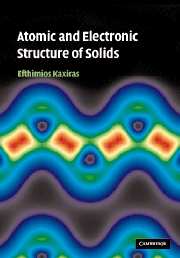Book contents
- Frontmatter
- Contents
- Preface
- Acknowledgments
- I Crystalline solids
- 1 Atomic structure of crystals
- 2 The single-particle approximation
- 3 Electrons in crystal potential
- 4 Band structure of crystals
- 5 Applications of band theory
- 6 Lattice vibrations
- 7 Magnetic behavior of solids
- 8 Superconductivity
- II Defects, non-crystalline solids and finite structures
- III Appendices
- References
- Index
5 - Applications of band theory
Published online by Cambridge University Press: 06 July 2010
- Frontmatter
- Contents
- Preface
- Acknowledgments
- I Crystalline solids
- 1 Atomic structure of crystals
- 2 The single-particle approximation
- 3 Electrons in crystal potential
- 4 Band structure of crystals
- 5 Applications of band theory
- 6 Lattice vibrations
- 7 Magnetic behavior of solids
- 8 Superconductivity
- II Defects, non-crystalline solids and finite structures
- III Appendices
- References
- Index
Summary
In the previous chapter we examined in detail methods for solving the single-particle equations for electrons in solids. The resulting energy eigenvalues (band structure) and corresponding eigenfunctions provide insight into how electrons are arranged, both from an energetic and from a spatial perspective, to produce the cohesion between atoms in the solid. The results of such calculations can be useful in several other ways. The band structure of the solid can elucidate the way in which the electrons will respond to external perturbations, such as absorption or emission of light. This response is directly related to the optical and electrical properties of the solid. For example, using the band structure one can determine the possible optical excitations which in turn determine the color, reflectivity, and dielectric response of the solid. A related effect is the creation of excitons, that is, bound pairs of electrons and holes, which are also important in determining optical and electrical properties. Finally, the band structure can be used to calculate the total energy of the solid, from which one can determine a wide variety of thermodynamic and mechanical properties. In the present chapter we examine the theoretical tools for calculating all these aspects of a solid's behavior.
Density of states
A useful concept in analyzing the band structure of solids is the density of states as a function of the energy. To illustrate this concept we consider first the free-electron model. The density of states g(∈)d∈ for energies in the range [∈, ∈ + d∈] is given by a sum over all states with energy in that range.
- Type
- Chapter
- Information
- Atomic and Electronic Structure of Solids , pp. 160 - 202Publisher: Cambridge University PressPrint publication year: 2003

